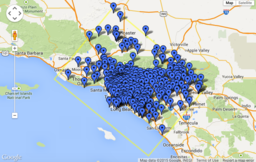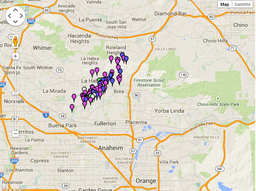Difference between revisions of "HighF v14.12"
| Line 53: | Line 53: | ||
**[http://hypocenter.usc.edu/research/High-F/merged_lahabra_sites.kml Merged (SMO + SCECDC) Site KML Map (KML File) ] | **[http://hypocenter.usc.edu/research/High-F/merged_lahabra_sites.kml Merged (SMO + SCECDC) Site KML Map (KML File) ] | ||
**[http://hypocenter.usc.edu/research/High-F/merged_lahabra_sites.txt Merged (SMO + SCECDC) Site List (TXT File)] | **[http://hypocenter.usc.edu/research/High-F/merged_lahabra_sites.txt Merged (SMO + SCECDC) Site List (TXT File)] | ||
| − | |||
| − | |||
| − | |||
| − | |||
| − | |||
| − | |||
| − | |||
| − | |||
| − | |||
| − | |||
[[Image:Merged smoscecdc labra sites.png|256px|thumb|right|Fig 1: 356 La Habra Earthquake ground motion accelerometer recordings for the La Habra Earthquake in Simulation Volume]] | [[Image:Merged smoscecdc labra sites.png|256px|thumb|right|Fig 1: 356 La Habra Earthquake ground motion accelerometer recordings for the La Habra Earthquake in Simulation Volume]] | ||
Revision as of 04:14, 31 March 2015
This page collects information about a proposed high frequency verification and validation exercise. Planning started in Dec 2014.
Contents
- 1 Goal
- 2 Approach
- 3 Problem Statement
- 4 Simulation Region
- 5 Source Description
- 6 1D Velocity Model Definition
- 7 Station List
- 8 Simulation Box / Velocity Model
- 9 Solver Parameters
- 10 High-F VandV Exercise Planning Documents (2015)
- 11 High-F Project Plan (2012)
- 12 Agreements Needed
- 13 Related Entries
- 14 References Used
Goal
Most regional scale deterministic earthquake simulation verification and validation exercises have been done at frequencies 1Hz or lower [1] [2]. With the introduction of high performance CPU and CPU-GPU wave propagation codes, there has been significant recent progress running simulations up to 4Hz. As we increase the capabilities of our deterministic earthquake simulation codes, we need to re-evaluate the codes performance at these higher frequencies that are now possible. The goal of this activity is to evaluate the performance of multiple wave propagation codes that are capable of simulation regional scale earthquakes at frequencies 4Hz+.
Approach
High frequency simulations introduce several code modifications intended to more accurately model the physics of high frequency earthquake wave propagation simulations. Modification to existing wave propagation codes to support 1Hz+ simulations include:
- Source descriptions with energy above 1Hz
- Small scale heterogeneities in the 3D velocity models
- Frequency dependent attenuation
- Near fault plastic yielding
- Large displacement plastic yielding
To help isolate the impact of each of these changes, we propose to start with simple (possibly unrealistic) high frequency (4Hz) ground motion simulations and compare the simulation results produced by different methods. Then we will introduce these modifications one at a time, as a way if isolating the impact of each change individually.
Problem Statement
We have defined common input parameters for use by both AWP-ODC, and Hercules. The problem statements includes the following parameters:
- Simulation Region
- Source Description
- Station List
- Velocity Model
- Simulation Duration
- Simulated Frequency Range
- Sample per Wavelength
Simulation Region
The simulation region four corners are given in the table below:
Volume size:
- 180,000 m x 135,000 m x 61,875 m = 1.503e15 m3
Source Description
We will use a rough-fault dynamic-rupture-based point source produced by Zheqiang Shi (SDSU) that has frequencies above 4Hz, scaled to Mw5.1 La Habra. The source is plotted and defined in the following files. These show the source trimmed, low-pass filtered (fc=5Hz, Butterworth, 2 forward passes, 4 poles), 4300 points, dt=0.001s (and plot of what is should look like).
- Time domain Plot of Selected Source
- Source Frequency Domain Plot w/ and w/o Filtering
- Data File For 5Hz Plot (Source after filtering)
1D Velocity Model Definition
The first velocity model will be modeled on a 1D model of the Los Angeles Basin used in on the Broadband Platform project. The model was smoothed to eliminate sharp contrasts between layers.
- Diagram of smoothed 1D Model (pdf)
- Diagram of smoothed 1D Model showing Layers (pdf)
- 1D model data file (20m resolution) (rtf)
Definition of Los Angeles Basin 1D velocity models used in the Broadband Platform project:
Station List
We developed a list of ground motion observations for the La Habra earthquake. A description of the methods used to create this merged site list are provided at Selection of La Habra Ground Motion Observations.
This site list is based on use of publicly posted data sets for the La Habra event. There should be on-scale accelerometer ground motion data at all of these sites for the La Habra mainshock. We have not yet plotted all data to visually confirm the data is above noise, and on-scale. This list combine all channels available from SMO and SCECDC for the La Habra Event using only acceleration instruments within the simulation region:
- Total SMO and SCECDC [HN] Stations in simulation region : 356
Simulation Box / Velocity Model
| Parameter | Value | Notes |
|---|---|---|
| Dimensions (km) | 180 x 135 x 61.875 (31 km for 1d Model) | |
| Bounding Box (LL) | -119.288842 34.120549, -118.354016 35.061096, -116.846030 34.025873, -117.780976 33.096503 | |
| Rotation Angle | 39.9 | |
| UCVM Version | 14.3.0 | No heterogeneities |
| Velocity Model Versions | CVM-S4v26 | |
| Miniumum Vs | 500 m/s | |
| Samples per wavelength | 6 to 7 - AWP | 10 to 12 - Hercules |
Point Source Parameters
| Parameter | Value | Notes |
|---|---|---|
| Event Name | La Habra | |
| Mw | 5.1 | Ref: http://www.scsn.org/2014lahabra.html |
| Moment | 5.764 E+23 Dyne-cm | Source: En-Jui |
| Origin Time | 2014/03/29 04:09:42.97 | Source: En-Jui |
| Origin Location | -117.930; 33.922; 5.0km | Source: En-Jui |
| Strike/Dip/Rake | 239/70/38 | Source: En-Jui, based on review of aftershock sequence |
| Rise Time | 0.75 s |
Solver Parameters
| Parameter | Value | Notes |
|---|---|---|
| Frequency | 4.0 Hz | |
| Simulation Length (Duration) | 100 s | |
| Delta T | 0.005 | |
| Plane Output Resolution | 250m | |
| I/O Print Rate | every 10 steps | |
| Station List | TBD | |
| Software Version | TBD |
High-F VandV Exercise Planning Documents (2015)
High-F Project Plan (2012)
Agreements Needed
- Simulation Volumes
- Rotation Angle
- Projections used
- Points per wavelength used
- Number and location of sites used for ground motion comparison
- Proposed Station List to save results
- La Habra Point Source parameters
- Currently available code capabilities in GPU codes
- small scale heterogeneities
- FDQ
- Plasticity
- dynamic rupture source
- V and V exercise stages - need to be reviiewed and approved
Related Entries
References Used
- Taborda, R. and J. Bielak (2013). Ground-motion simulation and validation of the 2008 Chino Hills, California, earthquake, Bull. Seismol. Soc. Am. 103, no. 1, 131–156, doi 10.1785/0120110325.

